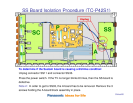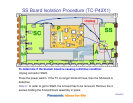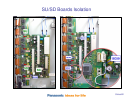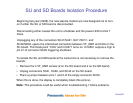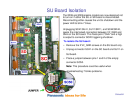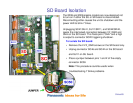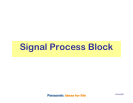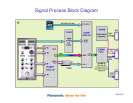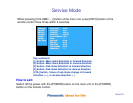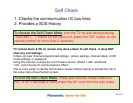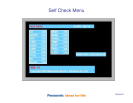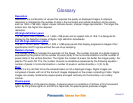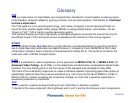
Slide #68
Signal Process Explanation
The main function of the A board is to select and process one of the incoming video signals. Video inputs 1 and 2, Component
Video Inputs 1 and 2, PC input, and the composite video output of the tuner are all are connected to IC3001 for selection. The
video output signal of the switch can be in any of the three formats: Video, Y/C, or Y, Pb, Pr. The selected output enters
IC8001.
A comb filter inside IC8001 converts the composite video signal of the main picture to Y and C (luminance and chrominance)
signals. S-Video, which is already Y/C separated, simply passes through the comb filter.
At the completion of this process, the format of the composite or S-Video signal is now the same as a digital 480i component
signal. If the incoming video is in the 480p, 720P, or 1080i format, the Y, Pb, and Pr signals undergo A/D (analog to digital)
conversion only. The 10 bit YUV data is provided to a video switch.
The HDMI receiver section of IC4503 converts the incoming HDMI signals to a YUV video signal. The output of the switch is
provided to another switch located inside the PEAKS LITE IC, IC8001.
Digital television reception of the tuner is output in the form of an IF (Intermediate Frequency) signal
The transport stream from the tuner enters the VSB I/F (Interface) section of IC8001 where the video signal is extracted and
converted to YUV data. The output is provided to the Video Input I/F for selection. The JPEG data of the SD card enters the
JPEG I/F section of IC8001 for conversion into YUV data and output to the Video Input I/F circuit. The video input interface
outputs the selected picture data to the video process circuit.
This Video Process section of the IC performs all picture control operations such as brightness, contrast, color, tint, etc. On
Screen Display data such as channel numbers, Digital TV closed caption, and picture adjustments are mixed with the video
data. LVDS (Low Voltage Differential Signaling) is output to IC9900 (Plasma AI, H/V Sync Control, and Sub-field Processor).
The Plasma AI (Adaptive brightness Intensifier) circuit analyzes the video program level for the distribution of dark and bright
components. This circuit is also used to speed up the scanning process and control the number of sustain periods. This
increases the brightness and improves the contrast ratio.
The data drive signals are output to the C1 and C2 boards. The C1 board drives the right portion of the panel and the C2 board
drives the left portion
IC9500 provides the scan, sustain and data drive signals.
The scan pulses are output to the SC board.
The sustain pulses are output to the SS board.
The main MCU handles all video applications. It serves as the controller that monitors all operations of the TV section (not
display) of the unit.



